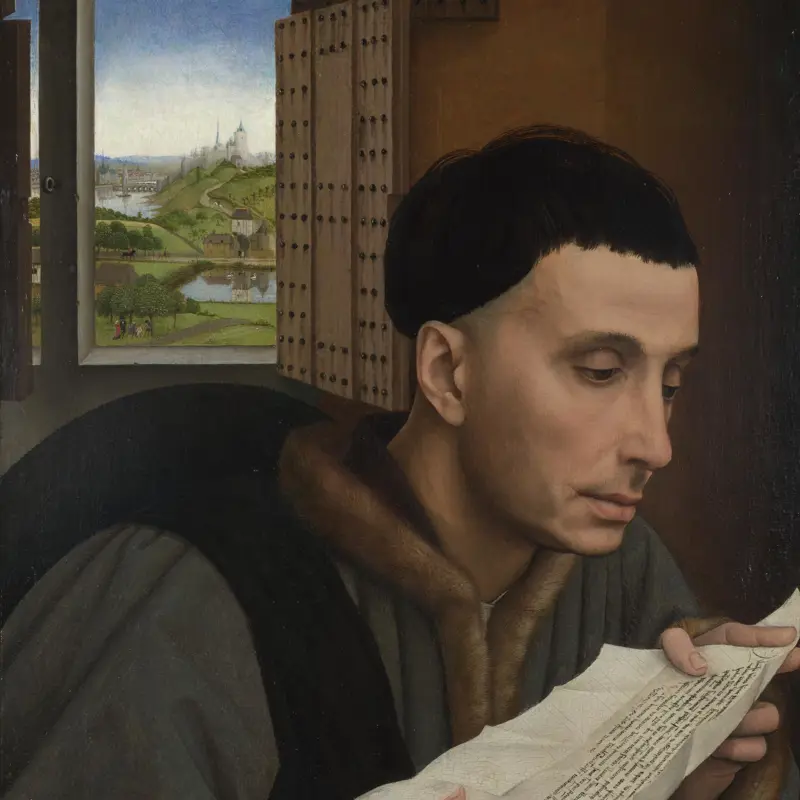Rogier van der Weyden, 'The Magdalen Reading', about 1435
About the work
Overview
A young lady in an extravagant green dress sits on the floor, reading. Although she wears fifteenth-century clothing and is in a medieval room, she is a biblical figure: Saint Mary Magdalene. The pot of oil with which she anointed Christ’s feet – the object traditionally associated with her – stands on the floor beside her casting a strong shadow. Her figure forms a semi-circle, with her head and legs curving around her bent knees, emphasising her absorption in her book.
This painting was originally the lower right corner of what must have been a large altarpiece of the Virgin and Child with saints, painted for a church in Brussels. You can see part of a man behind Mary while another kneels to the left; his toes poke out from under his voluminous red robe.
Key facts
Details
- Full title
- The Magdalen Reading
- Artist
- Rogier van der Weyden
- Artist dates
- About 1399 - 1464
- Date made
- About 1435
- Medium and support
- Oil, originally on wood, transferred to wood (mahogany, identified)
- Dimensions
- 62.2 × 54.4 cm
- Acquisition credit
- Bought, 1860
- Inventory number
- NG654
- Location
- Room 52
- Collection
- Main Collection
- Frame
- 21st-century Replica Frame
Provenance
Additional information
Text extracted from the ‘Provenance’ section of the catalogue entry in Lorne Campbell, ‘National Gallery Catalogues: The Fifteenth Century Netherlandish Schools’, London 1998; for further information, see the full catalogue entry.
Exhibition history
-
2008The birth of modern painting: Robert Campin, the Master of Flémalle, and Rogier van der WeydenStädelsches Kunstinstitut und Städtische Galerie21 November 2008 - 1 March 2009Staatliche Museen zu Berlin - Preußischer Kulturbesitz20 March 2009 - 21 June 2009
-
2009Rogier van der Weyden 1400-1464: Master of PassionsM - Museum Leuven20 September 2009 - 6 December 2009
Bibliography
-
1898H. von Tschudi, 'Der Meister von Flémalle', Jahrbuch der Königlich Preussischen Kunstsammlungen, XIX, 1898, pp. 8-34, 89-116
-
1929E. Renders, 'The Riddle of the Maître de Flémalle', The Burlington Magazine, LIV/315, 1929, pp. 285-303
-
1945Davies, Martin, National Gallery Catalogues: Early Netherlandish School, London 1945
-
1953M. Davies, The National Gallery, London, Les Primitifs flamands. I, Corpus de la peinture des anciens Pay-Bas méridionaux au quinzième siècle 3, 2 vols, Antwerp 1953
-
1953E. Panofsky, Early Netherlandish Painting: Its Origins and Character, Cambridge 1953
-
1955Davies, Martin, National Gallery Catalogues: Early Netherlandish School, 2nd edn (revised), London 1955
-
1957M. Davies, 'Rogier Van Der Weyden's "Magdalen Reading"', in D. Englebert (ed.), Miscellanea Prof. Dr D. Roggen, Antwerp 1957, pp. 77-89
-
1967M.J. Friedländer, Early Netherlandish Painting, eds N. Veronée-Verhaegen and H. Pauwels, trans. H. Norden, 14 vols, Leiden 1967
-
1971J.L. Ward, 'A Proposed Reconstruction of an Altarpiece by Rogier van der Weyden', Art Bulletin, LIII/1, 1971, pp. 27-35
-
1987Davies, Martin, National Gallery Catalogues: The Early Netherlandish School, 3rd edn, London 1987
-
1994L. Campbell, 'Rogier van der Weyden and His Workshop', Proceedings of the British Academy, LXXXIV, 1994, pp. 16-20
-
1998Campbell, Lorne, National Gallery Catalogues: The Fifteenth Century Netherlandish Paintings, London 1998
-
1999S. Kemperdick, Rogier van der Weyden, 1399/1400-1464, Cologne 1999
-
1999D. de Vos, Rogier van der Weyden: The Complete Works, Antwerp 1999
-
2000A. Acres, 'Rogier van der Weyden's Painted Texts', Artibus et historiae, XXI/41, 2000, pp. 75-109
-
2001
C. Baker and T. Henry, The National Gallery: Complete Illustrated Catalogue, London 2001
-
2002D. Bomford et al., Underdrawings in Renaissance Paintings (exh. cat. The National Gallery, 30 October 2002 - 16 February 2003), London 2002
-
2008S. Kemperdick and J. Sanders, The Master of Flémalle and Rogier van der Weyden (exh. cat. Städel Museum, 21 November 2008 - 22 February 2009; Gemäldegalerie, 20 March - 21 June 2009), Ostfildern-Ruit 2008
About this record
If you know more about this work or have spotted an error, please contact us. Please note that exhibition histories are listed from 2009 onwards. Bibliographies may not be complete; more comprehensive information is available in the National Gallery Library.







